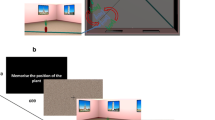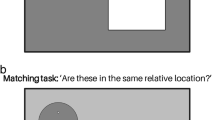Abstract
This study sought evidence for the independenceof two classes of mental spatialtransformation: object-based spatialtransformations and egocentric perspectivetransformations. Two tasks were designed toselectively elicit these two transformationsusing the same materials, participants, andtask parameters: one required same-differentjudgments about pairs of pictures, while theother required left-right judgments aboutsingle pictures. For pictures of human bodies,the two tasks showed strikingly differentpatterns of response time as a function ofstimulus orientation. Moreover, acrossindividuals, the two tasks had differentrelationships to psychometric tests of spatialability. The chronometric and individualdifference data converge withneuropsychological and neuroimaging data insuggesting that different mental spatialtransformations are performed by dissociableneural systems.
Similar content being viewed by others
References
Bonda, E., Petrides, M., Frey, S. and Evans, A. (1995). Neural correlates of mental transformations of the body-in-space. Proceedings Of the National Academy Of Sciences Of the United States Of America 92: 11180–11184.
Bryant, D.J. and Tversky, B. (1999). Mental representations of perspective and spatial relations from diagrams and models. Journal of Experimental Psychology: Learning, Memory, and Cognition 25: 137–156.
Cohen, J.D., MacWhinney, B., Flatt, M. and Provost, J. (1993). PsyScope: An interactive graphic system for designing and controlling experiments in the psychology laboratory using Macintosh computers. Behavior Research Methods, Instruments and Computers 25: 257–271.
Cooper, L.A. and Shepard, R.N. (1973). The time required to prepare for a rotated stimulus. Memory and Cognition 1: 246–250.
Cooper, L.A. and Shepard, R.N. (1975). Mental transformations in identification of left and right hands. Journal Of Experimental Psychology-Human Perception and Performance 104: 48–56.
Dabbs, J.M., Jr., Chang, E.L., Strong, R.A., and Milun, R. (1998). Spatial ability, navigation strategy, and geographic knowledge among men and women. Evolution and Human Behavior 19: 89–98.
Eals, M. and Silverman, I. (1994). The hunter-gatherer theory of spatial sex differences: Proximate factors mediating the female advantage in recall of object arrays. Ethology and Sociobiology 15: 95–105.
Hegarty, M. and Kozhevnikov, M. (1999). Spatial reasoning abilities, working memory, and mechanical reasoning. In J.S. Gero and B. Tversky (eds.), Visual and Spatial Reasoning in Design (pp. 1–19). Sydney: Key Center of Design Computing and Cognition.
Huttenlocher, J. and Presson, C.C. (1973). Mental rotation and the perspective problem. Cognitive Psychology 4: 277–299.
Jolicoeur, P. (1985). The time to name disoriented natural objects. Memory and Cognition 13: 289–303.
Jolicoeur, P. (1988). Mental rotation and the identification of disoriented. Canadian Journal of Psychology 42.
Just, M.A. and Carpenter, P.A. (1985). Cognitive coordinate systems: Accounts of mental rotation and individual differences in spatial ability. Psychological Review 92: 137–172.
Koriat, A. and Norman, J. (1984). What is rotated in mental rotation? Journal of Experimental Psychology: Learning, Memory, and Cognition 10: 421–434.
Koriat, A. and Norman, J. (1988). Frames and images: Sequential effects in mental rotation. Journal of Experimental Psychology: Learning, Memory, and Cognition 14: 93–111.
Kosslyn, S.M. (1994). Image and brain: the resolution of the imagery debate. Cambridge, Mass.: MIT Press.
Meng, X.-L., Rosenthal, R. and Rubin, D.B. (1992). Comparing correlated correlation coefficients. Psychological Bulletin 111: 172–175.
Money, J. and Alexander, D. (1966). Turner's syndrome: further demonstration of the presence of specific cognitional deficiencies. Journal of Medical Genetics 3: 47–48.
Montello, D.R., Lovelace, K.L., Golledge, R.G. and Self, C.M. (1999). Sex-related differences and similarities in geographic and environmental spatial abilities. Annals of the Association of American Geographers 89: 515–534.
Parsons, L.M. (1987a). Imagined spatial transformation of one's body. Journal of Experimental Psychology: General 116: 172–191.
Parsons, L.M. (1987b). Visual discrimination of abstract mirror-reflected three-dimensional objects at many orientations. Perception and Psychophysics 42: 49–59.
Parsons, L.M. (1994). Temporal and kinematic properties of motor behavior reflected in mentally simulated action. Journal of Experimental Psychology: Human Perception and Performance 20: 709–730.
Parsons, L.M., Fox, P.T., Downs, J.H., Glass, T., Hirsch, T.B., Martin, C.C., Jerabek, P.A. and Lancaster, J.L. (1995). Use of implicit motor imagery for visual shape discrimination as revealed by PET. Nature (London) 375: 54–58.
Presson, C.C. (1980). Spatial egocentrism and the effect of an alternate frame of reference. Journal of Experimental Child Psychology 29: 391–402.
Presson, C.C. (1982). Strategies in spatial reasoning. Journal of Experimental Psychology: Learning, Memory and Cognition 8: 243–251.
Pylyshyn, Z.W. (1979). The rate of mental rotation of images: A test of a holistic analogue hypothesis. Memory and Cognition 7: 19–28.
Ratcliff, G. (1979). Spatial thought, mental rotation and the right cerebral hemisphere. Neuropsychologia 17: 49–54.
Robertson, L.C., Palmer, S.E. and Gomez, L.M. (1987). Reference frames in mental rotation. Journal of Experimental Psychology: Learning, Memory, and Cognition 13: 368–379.
Sekiyama, K. (1982). Kinesthetic aspects of mental representations in the identification of left and right hands. Perception and Psychophysics 32: 89–95.
Semmes, J., Weinstein, S., Ghent, L. and Teuber, H.-L. (1963). Correlates of impaired orientation in personal and extrapersonal space. Brain 86: 747–772.
Shepard, R.N. and Cooper, L.A. (1982). Mental images and their transformations. Cambridge, Mass.: MIT Press.
Shepard, R.N. and Metzler, J. (1971). Mental rotation of three-dimensional objects. Science 171: 701–703.
Silverman, I. and Eals, M. (1992). Sex differences in spatial abilities: Evolutionary theory and data. In J.H. Barkow and L. Cosmides (eds.), The Adapted Mind: Evolutionary Psychology and the Generation of Culture (pp. 533–549). New York, NY, USA: Oxford University Press.
Vandenberg, S.G. and Kuse, A.R. (1978). Mental rotations, a group test of three-dimensional spatial visualization. Perceptual and Motor Skills 47: 599–604.
Wexler, M., Kosslyn, S.M. and Berthoz, A. (1998). Motor processes in mental rotation. Cognition 68: 77–94.
Wohlschläger, A. and Wohlschläger, A. (1998). Mental and manual rotation. Journal of Experimental Psychology: Human Perception and Performance 24: 397–412.
Wraga, M., Creem, S.H. and Proffitt, D.R. (2000). Updating scenes after object-and viewerrotations. Journal of Experimental Psychology: Learning, Memory and Cognition 26: 151–168.
Zacks, J., Hazeltine, E., Tversky, B. and Gabrieli, J.D.E. (1999a). Event-related fMRI of mental spatial transformations. Paper presented at the Annual Meeting of the Cognitive Neuroscience Society, Washington, DC.
Zacks, J., Rypma, B., Gabrieli, J., Tversky, B. and Glover, G. (1999b). Imagined transformations of bodies: an fMRI study. Neuropsychologia 37: 1029–1040.
Author information
Authors and Affiliations
Rights and permissions
About this article
Cite this article
Zacks, J.M., Mires, J., Tversky, B. et al. Mental spatial transformations of objects and perspective. Spatial Cognition and Computation 2, 315–332 (2000). https://doi.org/10.1023/A:1015584100204
Issue Date:
DOI: https://doi.org/10.1023/A:1015584100204




